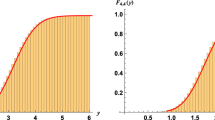Abstract
It is well known that, on a purely algebraic level, a simplified version of the central limit theorem (CLT) can be proved in the framework of a non-commutative probability space, under the hypotheses that the sequence of non-commutative random variables we consider is exchangeable and obeys a certain vanishing condition of some of its joint moments. In this approach (which covers versions for both the classical CLT and the CLT of free probability), the determination of the resulting limit law has to be addressed on a case-by-case basis. In this paper we discuss an instance of the above theorem that takes place in the framework of the group algebra \({{\mathbb {C}}}[ S_{\infty } ]\) of the infinite symmetric group: The exchangeable sequence is provided by the star-generators of \(S_{\infty }\), and the expectation functional used on \({{\mathbb {C}}}[ S_{\infty } ]\) depends in a natural way on a parameter \(d \in {{\mathbb {N}}}\). We identify precisely the limit distribution \(\mu _d\) for this special instance of CLT, via a connection that \(\mu _d\) turns out to have with the average empirical eigenvalue distribution of a random \(d \times d\) GUE matrix. Moreover, we put into evidence a multivariate version of this result which follows from the observation that, on the level of calculations with pair-partitions, the (non-centered) star-generators are related to a (centered) exchangeable sequence of GUE matrices with independent entries.
Similar content being viewed by others
Notes
The sequence \( ( a_n )_{n=1}^{\infty } \) considered in this definition is not assumed to be exchangeable.
The restriction of \(\pi \) to A is the partition of A into the blocks \(\{ A \cap V \mid V \in \pi \text{ and } A \cap V \ne \emptyset \}\).
The value of \(\ell \) appearing here is sure to be such that \(\ell \ne i\), but it is not ruled out that we have \(\ell = j\). In the latter case, the outcome of Case 3-2 is that j is a fixed point for \(q_{\pi }\).
References
Anderson, G.W., Guionnet, A., Zeitouni, O.: An Introduction to Random Matrices. Cambridge University Press, Cambridge (2009)
Biane, P.: Permutation model for semi-circular systems and quantum random walks. Pacific J. Math. 171, 373–387 (1995)
Borodin, A., Olshanski, G.: Representations of the Infinite Symmetric Group. Cambridge University Press, Cambridge (2016)
Bozejko, M., Guta, M.: Functors of white noise associated to characters of the infinite symmetric group. Commun. Math. Phys. 229, 209–227 (2002)
Bozejko, M., Speicher, R.: Interpolations between bosonic and fermionic relations given by generalized Brownian motions. Mathematische Zeitschrift 160, 135–160 (1996)
Féray, V.: Partial Jucys–Murphy elements and star factorizations. Eur. J. Comb. 33, 189–198 (2012)
Gnedin, A., Gorin, V., Kerov, S.: Block characters of the symmetric groups. J. Algebraic Comb. 38, 79–101 (2013)
Gohm, R., Köstler, C.: Noncommutative independence from characters of the infinite symmetric group \(S_{\infty }\). arXiv:1005.5726
Goulden, I.P., Jackson, D.M.: Transitive powers of Young—Jucys–Murphy elements are central. J. Algebra 321, 1826–1835 (2009)
Haagerup, U., Thorbjornsen, S.: Random matrices with complex Gaussian entries. Expositiones Mathematicae 21, 293–337 (2003)
Irving, J., Rattan, A.: Factorizations of permutations into star transpositions. Discrete Math. 309, 1435–1442 (2009)
Nica, A., Speicher, R.: Lectures on the Combinatorics of Free Probability. Cambridge University Press, Cambridge (2006)
Olshanski, G.: An introduction to harmonic analysis on the infinite symmetric group. In: Vershik, A.M. (ed.) Asymptotic Combinatorics with Applications to Mathematical Physics, volume 1815 of the Lecture Notes in Mathematics Series, pp. 127–160. Springer, Berlin (2003)
Pak, I.: Reduced decompositions of permutations in terms of star transpositions, generalized Catalan numbers and \(k\)-ary trees. Discrete Math. 204, 329–335 (1999)
Speicher, R.: Random matrices and combinatorics. In: Voiculescu, D.-V., Stammeier, N., Weber, M. (eds.) Free Probability and Operator Algebras, pp. 17–38. European Mathematical Society Publishing House, Zurich (2016)
Acknowledgements
We are grateful to the anonymous referees for their careful reading and for thought-provoking comments which led to significant improvements in the first version of the paper. A.N. would also like to thank Alexandru Gatea for useful discussions at an early stage of this project.
Author information
Authors and Affiliations
Corresponding author
Additional information
Publisher's Note
Springer Nature remains neutral with regard to jurisdictional claims in published maps and institutional affiliations.
Alexandru Nica: research supported by a Discovery Grant from NSERC, Canada.
Rights and permissions
About this article
Cite this article
Köstler, C., Nica, A. A Central Limit Theorem for Star-Generators of \({S}_{\infty }\), Which Relates to the Law of a GUE Matrix. J Theor Probab 34, 1248–1278 (2021). https://doi.org/10.1007/s10959-020-01029-6
Received:
Revised:
Published:
Issue Date:
DOI: https://doi.org/10.1007/s10959-020-01029-6
Keywords
- Non-commutative probability space
- Algebraic central limit theorem
- Exchangeable sequence of random variables
- Star-generators of symmetric groups
- GUE random matrix



